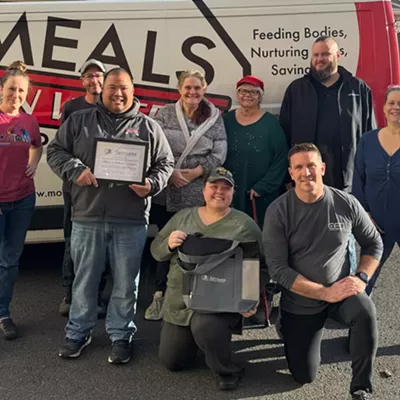It’s 8 o’clock in the morning and a group of clients are getting ready for the first dive of the day. They don plastic headgear that resembles something Buzz Lightyear might wear and get ready for their descent. Though they won’t actually be going underwater, it will feel as though they’re more than 16 feet deep — the equivalent of 1.5 atmospheres of pressure. Later in the morning, another dive group will descend to the equivalent of 33 feet. These pseudo-divers are hoping to benefit from a combination of increased atmospheric pressure and breathing 100 percent oxygen at the Spokane Hyperbaric Center in Spokane Valley.
Clients are seated in comfy leather chairs in the big cylinder that looks a whole lot like the famous yellow submarine, only with a shiny white paint job. There are a few portholes, one bearing a television, to view the outside world. To combat the unpleasant effects the changing pressure can have on their ears, they sip from water bottles or chew gum as they relax and read or watch TV. A technician accompanies them into the chamber, ready to assist anyone who is having trouble. Treatments last an hour, and usually take place twice a day over a 20-day period.
The rationale behind hyperbaric oxygen therapy is that by breathing in pure oxygen while under increased atmospheric pressure, oxygen will become dissolved in blood plasma. That means in addition to the normal oxygen being toted about on red blood cells, additional oxygen is available to the tissues as blood circulates. This oxygen diffuses into the tissues, where it can have a variety of effects, making the hyperbaric oxygen therapy potentially applicable to a wide range of diseases and disabilities.
“I think it will become the drug of choice for many disabilities,” says Medical Director Karen Stanek, M.D., PhD. In addition to her duties at the Center, Stanek has a private practice and is on the staff of St. Luke’s Rehabilitation Institute. For example, she explains, in patients who have experienced a stroke, the old theory held that cells damaged by a lack of oxygen were beyond repair. “The new theory is that these cells are in ‘shock mode,’ not dying,” she says.
“They don’t function well, but given the right environment, they may start to function again.” That’s the theory, and it seems to be holding up in practice. “I’ve seen so many stroke patients that even after years of traditional therapy, they plateau. The hyperbaric oxygen therapy seems to help them over that plateau,” she says. She adds that the sooner patients receive the hyperbaric oxygen therapy after their injuries, the better the results.
Patients who have had open-heart surgery often experience extreme fatigue, and hyperbaric therapy seems to help them. Other conditions treated at the center include multiple sclerosis, cerebral palsy and autism. “We see patients who have increased significantly in their energy, along with decreased spasticity and increased muscle strength,” she says. “We see kids with autism whostart talking and become much more social.”
Why does the therapy work for patients with such diverse diseases? Stanek says researchers aren’t entirely sure. It could be that the extra oxygen assists damaged cells, or maybe it is toxic to whatever is impairing those cells. Paradoxically, hyperbaric therapy promotes growth of some types of cancer, while being helpful in fighting other types.
With the potential for hyperbaric therapy to have a positive effect on such a variety of difficult-to-treat maladies, why isn’t there a line out the door? Stanek says there are scientific papers that do show benefits from hyperbaric oxygen therapy. However not all the research has been favorable — in some cases, scientists haven’t been able to clearly determine a benefit.
The FDA currently recognizes hyperbaric therapy for 13 conditions — they include carbon monoxide poisoning, some types of wounds and skin ulcers, and diving accidents. Since therapy at the hyperbaric center is for conditions outside those 13, it is considered experimental and is not covered by insurance. A series of 40 treatments runs about $5,600.
Stanek hopes some day insurance will cover the cost, but in the meantime, she is pleased with the results patients are getting. Since the April 2007 opening of the center, which is privately owned by other parties, she’s had only one client for whom the results were disappointing. The bottom line, Stanek says, is that hyperbaric oxygen therapy is “underutilized for many different diagnoses.”
To help change that, she has presented in-service workshops to Spokane stroke and multiple sclerosis support groups, and has networked with other physicians. She is hoping cognitive screening test results and videotaping of all patients before and after therapy may help convince some doubters.
The only other place patients can receive hyperbaric oxygen therapy in the area is at Deaconess Medical Center, where there’s a chamber for treating one patient at a time. Nurse Manager Jim Porter at Deaconess says the Spokane Hyperbaric Center is a welcome addition to the hyperbaric therapy community. “A lot of the things they treat are considered experimental. It’s been a nice thing for both of us, because we have to stick to the approved-use protocols.”
The chamber is probably the largest privately owned chamber in the U.S., says owner Dave Hensel. He’s an engineer and developer, and his partner is an architect. Together they’ve developed medical clinics and assisted living properties. Hensel says they were approached by St. Luke’s Rehabilitation Institute to build an assisted living center with a small hyperbaric chamber specifically for patients with traumatic brain injury. But after negotiations with the state regarding reimbursement fell through, Hensel says the idea of the chamber as a stand-alone facility still held interest.
“We had heard from several people that the chamber helped brain-injured people. We just got intrigued,” he says. “I’ve visited these things around the world. In Europe they use this for 65 different items, in Asia, 75, in South Korea, Russia and China, approximately 90.”
Stanek cautions that hyperbaric therapy is not a miracle cure, but another tool for physicians to use to help their patients. “It’s not for everybody. It has its place just like any other treatment.”




















